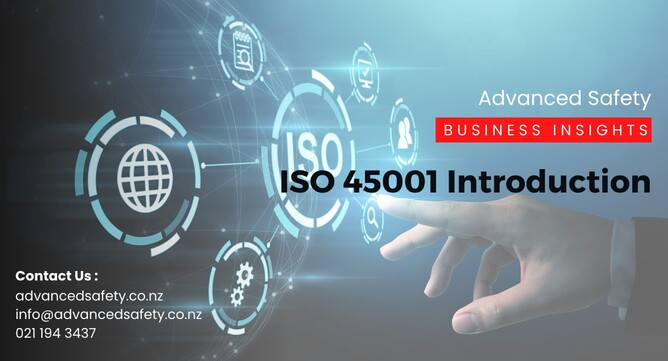ISO 45001 has become an essential framework for New Zealand businesses dedicated to improving workplace safety. As an international standard for Occupational Health and Safety Management Systems (OHSMS), it provides organisations with the tools to proactively manage risks, enhance safety culture, and support employee well-being.
This introduction to ISO 45001 explores its alignment with New Zealand’s regulations, and how businesses can benefit from its implementation.
Understanding ISO 45001
ISO 45001 is the first global standard for OHSMS, designed to help organisations reduce workplace injuries and illnesses while improving overall safety performance. Its framework focuses on proactive risk management, continual improvement, and fostering a culture of safety.
Key features of ISO 45001 include:
Structured processes for identifying and mitigating risks.
Emphasis on leadership involvement in safety initiatives.
Systematic tracking of workplace incidents to improve performance.
Focus on worker engagement in health and safety processes.
By implementing ISO 45001, organisations can not only protect their workforce but also drive productivity and business growth.
Want to Improve Your Workplace Safety?
Contact Advanced Safety for professional guidance and support.
Contact Us TodayISO 45001 and Its Alignment with New Zealand Legislation
ISO 45001 aligns with New Zealand's Health and Safety at Work Act 2015 (HSWA), although it does not replace legal obligations. Businesses adopting ISO 45001 should consider its relationship with local regulations:
1. Compliance with HSWA
While ISO 45001 provides a framework for managing occupational health and safety, it must be paired with HSWA compliance. HSWA emphasises:
Proactive identification and mitigation of workplace hazards.
Engagement of employees in safety planning and management.
Legal accountability for employers and officers to ensure safe working conditions.
2. Shared Principles
Both ISO 45001 and HSWA focus on:
Risk identification and management.
Worker participation in safety initiatives.
Continuous improvement through performance monitoring and reviews.
Adopting ISO 45001 can enhance an organisation's compliance efforts, ensuring safer workplaces and supporting legal obligations.
Increasing Adoption of ISO 45001 in New Zealand
The adoption of ISO 45001 is gaining traction across sectors such as construction, manufacturing, and forestry in New Zealand. Key factors driving this trend include:
Global Recognition: ISO 45001’s international standing appeals to businesses engaged in global supply chains.
Transition from AS/NZS 4801: With the phasing out of AS/NZS 4801, ISO 45001 is becoming the preferred standard for occupational health and safety.
Alignment with Other ISO Standards: ISO 45001 integrates seamlessly with ISO 9001 (quality management) and ISO 14001 (environmental management), streamlining organisational processes.
Many organisations are adopting ISO 45001 to gain a competitive edge, enhance safety culture, and reduce workplace risks.
Discover The 4 Step Pathway To ISO Certification
Learn MoreBenefits of ISO 45001 for New Zealand Businesses
Implementing ISO 45001 offers numerous advantages for businesses, employees, and stakeholders:
Enhanced Workplace Safety
Reduces workplace injuries and illnesses through proactive risk management.
Improved Compliance
Aligns with New Zealand’s HSWA, ensuring organisations meet and exceed legal requirements.
Operational Efficiency
Decreases downtime caused by workplace incidents, improving overall productivity.
Cost Savings
Reduces ACC claims, medical expenses, and compliance costs associated with workplace hazards.
Employee Engagement
Boosts morale and participation by fostering a strong safety culture.
Enhanced Reputation
Demonstrates a commitment to high safety standards, attracting customers, employees, and investors.
Competitive Advantage
Positions businesses favourably in both local and international markets.
ISO 45001 integrates with other ISO standards
The standard can be seamlessly combined with others, such as ISO 9001 (quality management) and ISO 14001 (environmental management), enhancing efficiency ISO 45001 and Integration with Other ISO Standards
One of the strengths of ISO 45001 is its compatibility with other ISO standards. Using the Annex SL structure, ISO 45001 integrates seamlessly with:
ISO 9001: Ensuring consistency in quality and safety management.
ISO 14001: Addressing environmental and safety concerns simultaneously.
ISO 31000: Enhancing overall risk management strategies.
This integration reduces duplication, simplifies documentation, and aligns organisational goals, making it a powerful tool for comprehensive management systems.
Steps to Achieve ISO 45001 Certification
Becoming certified in ISO 45001 requires a systematic approach. Here’s a four-step pathway to certification readiness:
Gap Analysis
Assess your current safety management system to identify gaps against ISO 45001 requirements.
Action Plan
Develop a plan to address identified gaps, including resource allocation and timeline setting.
Implementation
Integrate ISO 45001 principles into daily operations, focusing on worker engagement and proactive risk management.
Certification Audit
Partner with an accredited certification body to undergo a formal audit and achieve ISO 45001 certification.
ISO 45001 in Action: Real-World Applications
The adoption of ISO 45001 is transforming industries across New Zealand. For example:
Construction: By implementing ISO 45001, companies mitigate risks associated with falls from heights and hazardous equipment.
Manufacturing: Businesses use the framework to streamline machinery safety processes and reduce workplace injuries.
Forestry: Proactive hazard identification and worker engagement ensure safer operations in high-risk environments.
Challenges in Implementing ISO 45001
Despite its benefits, implementing ISO 45001 comes with challenges, including:
Resource Allocation: Achieving certification requires time, money, and effort.
Employee Resistance: Workers may initially resist changes to established processes.
Training Requirements: Extensive training is needed to familiarise employees with the standard.
These challenges can be addressed with strong leadership, effective communication, and support from experienced consultants.
Conclusion: Why ISO 45001 Matters
ISO 45001 is revolutionising workplace safety in New Zealand by providing a structured, internationally recognised framework for managing occupational health and safety. Its alignment with HSWA, integration with other standards, and focus on proactive risk management make it a vital tool for businesses aiming to enhance safety culture, compliance, and operational performance.
By adopting ISO 45001, organisations can protect their workforce, reduce costs, and gain a competitive edge in today’s safety-conscious market.
For professional guidance on achieving ISO 45001 certification, contact Advanced Safety today.
Discover how the construction industry is adopting ISO 45001 to tackle their unique safety challenges in our second blog in this series.


